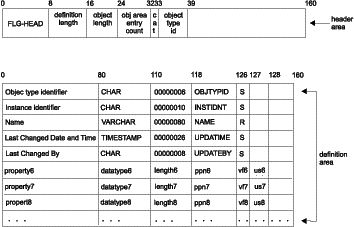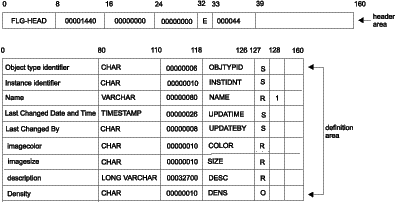
Retrieves the definition of all properties of an object type.
Authorization
Administrator or user
Syntax
APIRET APIENTRY FLGGetType( PSZ pszObjTypeID,
PFLGHEADERAREA * ppObjTypeStruct,
PFLGEXTCODE pExtCode );
Parameters
See Appendix D, Information Catalog Manager reason codes for an explanation of the returned reason codes.
Output structure
FLGGetType produces an output structure containing the property specifications of the requested object type, as shown in Figure 79.
The definition area of the output structure contains the properties of the requested object type in the order in which they were specified when the object type was created.
Figure 79. FLGGetType output structure

For an explanation of the meanings of the byte offsets, see Chapter 4, The Information Catalog Manager input and output structures.
Usage
Prerequisites
The value in the pszObjTypeID parameter must refer to an existing object type ID registered in the information catalog.
Freeing memory allocated for an output structure
If FLGGetType returned data in the output structure, you must save the data returned in the output structure and then call FLGFreeMem (see FLGFreeMem). Do not use other methods, for example, C language instructions, to free memory.
Figure 80 shows the C language code required to issue the FLGGetType API call. This sample code retrieves information about the properties of the MYIMAGE object type from the information catalog.
Figure 80. Sample C language call to FLGGetType
APIRET rc; // Declare reason code
UCHAR pszObjTypeID[FLG_OBJTYPID_LEN + 1]; // Set to ID of MYIMAGE (000044)
PFLGHEADERAREA * ppObjTypeStruct; // Pointer to the output structure
FLGEXTCODE ExtCode=0; // Declare extended code
.
. /* retrieving a user-defined object type - MYIMAGE */
strcpy (pszObjTypeID,"000044");
.
rc = FLGGetType (pszObjTypeID,
ppObjTypeStruct,
&ExtCode); // Pass pointer to extended code
Figure 81 shows the output structure that contains the property information for the MYIMAGE object type.
Figure 81. Sample output structure for FLGGetType
